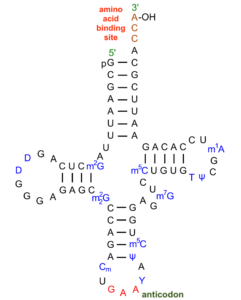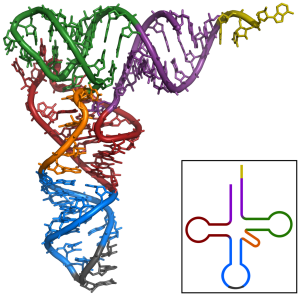1. Which Came 1st: Metabolism or Heredity?
Origin-of-life researchers can be roughly divided into two camps.
One camp is “Metabolism First.” Scientists in this camp believe that complex chains of chemical reactions arose abiotically. These reactions churned out monomers, which then, using any of the methods described in the last tutorial, would form polymers. As these polymers became more complex, various molecules that are essential for life’s functions would emerge. This would include nucleic acids for storing and expressing genetic information and proteins for efficiently catalyzing reactions.
On an abstract level, metabolism-first proponents are thinking like this:

In relation to the origin of life, the process looks like this:
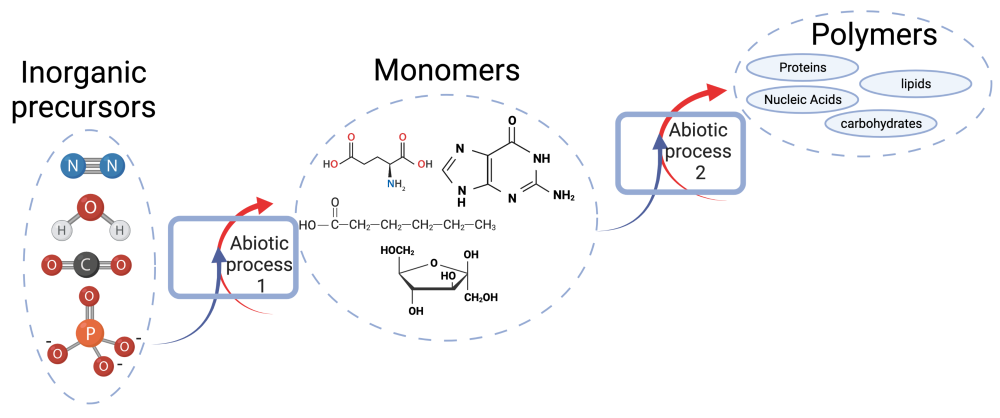
Metabolism first researchers want to figure out what these abiotic processes were, and where they could have occurred. We’ll explore this approach much more in the next tutorial when we look at undersea hydrothermal vents as a possible location for life’s origins.
The other camp is the “Genes First” camp. According to these scientists, what makes life distinct from non-life is life’s ability to reproduce itself. Let’s call a system that can reproduce itself a replicator. If during the reproduction process, mutations emerged that could lead to replicators that are more efficient at reproducing themselves, then there would start to be natural selection for the most effective replicators. This competition between replicators would lead the other features of life to emerge. Ultimately, we’d have genetic systems that created phenotypes that would reproduce those genetic systems.

Proponents of the Genes First approach have hypothesized that before cells, the first living things would have been populations of self-replicating RNA molecules. This proposed stage of life is called the RNA world.
2. The RNA World
2a. Why the first genetic system probably wasn’t DNA
Reproduction is a fundamental feature of any living system. In cells today (and probably all the way back to LUCA), reproduction is about passing on hereditary instructions encoded in DNA. But while DNA serves all living things as the repository (or library) of genetic information, it’s a poor candidate for having served as the first molecule of heredity.
One problem with DNA is that DNA encodes information for producing proteins, but an entire team of proteins is required for the reproduction of DNA. So we’re trapped in a “you can’t have a chicken without an egg and you can’t have an egg without a chicken” paradox. And it seems beyond the realm of possibility that a system of such complexity (see the diagram below) could have spontaneously arisen, with all of its parts, all at once.
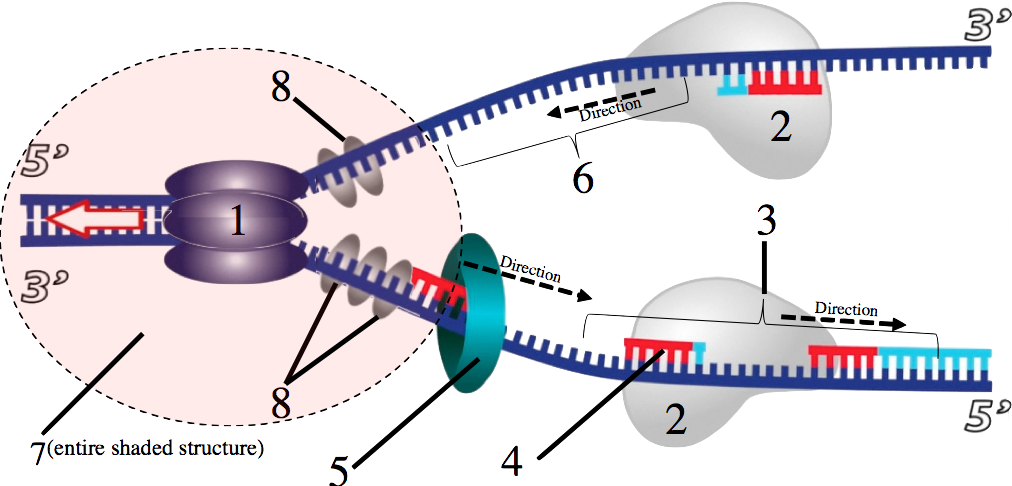
A better alternative for a first hereditary molecule is RNA (ribonucleic acid).
2b. RNA and DNA Review
You learned about the differences between DNA and RNA back in Unit 6. Use the following quiz to review.
[qwiz qrecord_id=”sciencemusicvideosMeister1961-RNA and DNA Review (v2.0)”]
[h]RNA and DNA Review
[i]
[q multiple_choice=”true”]The sugar is ribose
[c]RE5B[Qq]
[f]Tm8uIFJlbWVtYmVyIHRoYXQgUk5BIHN0YW5kcyBmb3IgJiM4MjIwO3JpYm9udWNsZWljwqAgYWNpZC4mIzgyMjE7[Qq]
[c]Uk 5B[Qq]
[f]Q29ycmVjdCEgSW4gUk5BLCB0aGUgc3VnYXIgaXMgcmlib3NlLg==[Qq]
[c]Ym90aCBETkEgYW5kIFJOQQ==[Qq]
[f]Tm8uIFJlbWVtYmVyIHRoYXQgUk5BIHN0YW5kcyBmb3IgJiM4MjIwO3JpYm9udWNsZWljwqAgYWNpZC4mIzgyMjE7[Qq]
[q]Both RNA and DNA are composed of monomers called [hangman]
[c]bnVjbGVvdGlkZXM=[Qq]
[q multiple_choice=”true”]The nitrogenous bases are A, T, C, and G
[c]RE 5B[Qq]
[f]TmljZS4gVGhlIG5pdHJvZ2Vub3VzIGJhc2VzIGluIEROQSBhcmUgYWRlbmluZSwgdGh5bWluZSwgY3l0b3NpbmUsIGFuZCBndWFuaW5lLg==[Qq]
[c]Uk5B[Qq]
[f]Tm8uIFJOQSB1c2VzIHVyYWNpbCBhcyBvcHBvc2VkIHRvIHRoeW1pbmUgaW4gRE5BLg==[Qq]
[c]Ym90aCBETkEgYW5kIFJOQQ==[Qq]
[f]Tm8uIFJOQSB1c2VzIHVyYWNpbCBhcyBvcHBvc2VkIHRvIHRoeW1pbmUgaW4gRE5BLg==[Qq]
[q]In all life forms, [hangman] stores genetic information, while [hangman] is used to express genetic information.
[c]RE5B[Qq]
[c]Uk5B[Qq]
[q multiple_choice=”true”]Usually single-stranded
[c]RE5B[Qq]
[f]Tm8uIEV4Y2VwdCBpbiBhIGZldyB2aXJ1c2VzLCBETkEgaXMgZG91YmxlLXN0cmFuZGVkLg==[Qq]
[c]Uk 5B[Qq]
[f]TmljZS4gRm9yIHRoZSBtb3N0IHBhcnQsIFJOQSBpcyBzaW5nbGUtc3RyYW5kZWQu[Qq]
[c]Ym90aCBETkEgYW5kIFJOQQ==[Qq]
[f]Tm8uIEZvciB0aGUgbW9zdCBwYXJ0LCBSTkEgaXMgc2luZ2xlLXN0cmFuZGVkLCBhbmQgRE5BIGlzIGRvdWJsZS1zdHJhbmRlZC4=[Qq]
[q labels = “top”]
| ________________________ | ______________________ |
| The sugar has two -OH (hydroxyl) groups. | The sugar has one -OH (hydroxyl), and one H. |
[l]deoxyribonucleotide
[fx] No. Please try again.
[f*] Correct!
[l]ribonucleotide
[fx] No, that’s not correct. Please try again.
[f*] Great!
[x][restart]
[/qwiz]
2c. Because it’s single-stranded, RNA is much more versatile than DNA
Because of DNA’s chemical structure, its most common three-dimensional shape is a double helix. That shape is great for storing information, but it doesn’t allow for much else besides that.
RNA can also store information. In fact, RNA is the information storage molecule in both RNA viruses and viroids, parasitic circles of RNA that infect plants. But because the nitrogenous bases within a single RNA molecule can bond with one another, an RNA molecule can twist and bend into an unlimited number of shapes. You can see internal hydrogen bonding and the 3-D folding that results in the two representations of a transfer RNA molecule shown below.
|
|
|
Internal bonding and folding are important because they allow RNA to do much more than just store information. RNA can also interact with the world. Some of the shapes that RNA folds up into produce RNAs that perform like enzymes, catalyzing chemical reactions. In other words, RNA can be both genotype and phenotype. This has been known since the 1980s, when catalytic RNAs, or ribozymes, were first discovered.
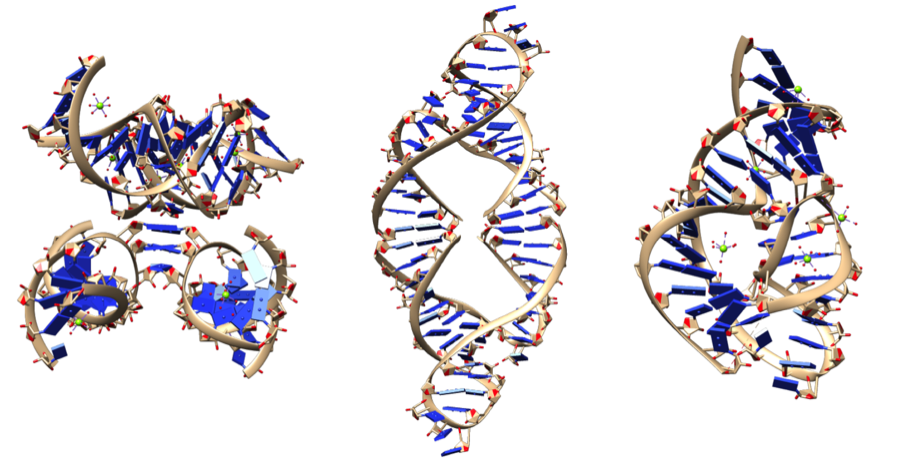
Ribozymes play a variety of roles in cells. In eukaryotic cells, ribozymes splice introns out of pre-mRNA, creating mRNA that can be translated into protein. During translation, the part of the ribosome that catalyzes new peptide bonds is made of RNA. In other words, RNA, in current living systems, can both synthesize new molecules and take molecules apart.
2d. What if a population of RNAs could reproduce itself? Welcome to the RNA world.
We established above that RNA can be genotype (information) and phenotype (action, as in ribozymes). The RNA world is a hypothetical stage in the evolution of life where RNA plays both roles.

The RNA world would have emerged before cells, and before LUCA. It would have consisted of populations of RNAs that could reproduce themselves. During the replication process, mutations would arise, leading to a type of natural selection. Those RNAs that could replicate more quickly and efficiently would come to dominate their populations, just as natural selection causes beneficial alleles to spread throughout a gene pool.
What’s the evidence for the RNA world? Theodor Diener, the discoverer of viroids (the infectious RNAs introduced above), has suggested that viroids are a vestige of the RNA world (click to read Diener’s arguments, and rebuttals). In addition, scientists are working on creating RNA self-replication systems in the laboratory. For example, a ribozyme that is 189 base pairs long has been created that can synthesize complementary RNA from a 14-nucleotide RNA template. Along the same lines, RNA ribozymes have been artificially selected that are capable of copying almost any other RNA…though not itself (see this Wikipedia article).
Watch the video below, which explains the RNA world.
RNA world advocates envision a step-by-step pathway from the abiotic production of monomers, to the formation of self-catalyzing RNAs, to the evolution of protein synthesis, to an association between RNA and DNA, to the first protocells.
 Here’s a relatively simple progression that ends in an RNA protocell.
Here’s a relatively simple progression that ends in an RNA protocell.
- Letter “a” represent inorganic precursors, which would abiotically evolve into RNA nucleotides (b).
- Letter “c” shows an RNA polymer in a linear strand, in a form that could store genetic information. Note that these 1st RNAs would have a random sequence (rather than one that is copied from a template, like RNA today).
- Letter “d” shows the RNA nucleotides within a strand forming internal hydrogen bonds. This would cause the RNA to fold up into a 3-D shape that could, potentially, have catalytic capabilities.
- Letter “e” shows the RNA serving as a template for its own replication.
- In letter “f” the RNA has become encapsulated within a membrane, forming a primitive protocell.
Here’s a representation that shows how RNA replicators could give rise to today’s DNA-RNA-Protein system within cells.
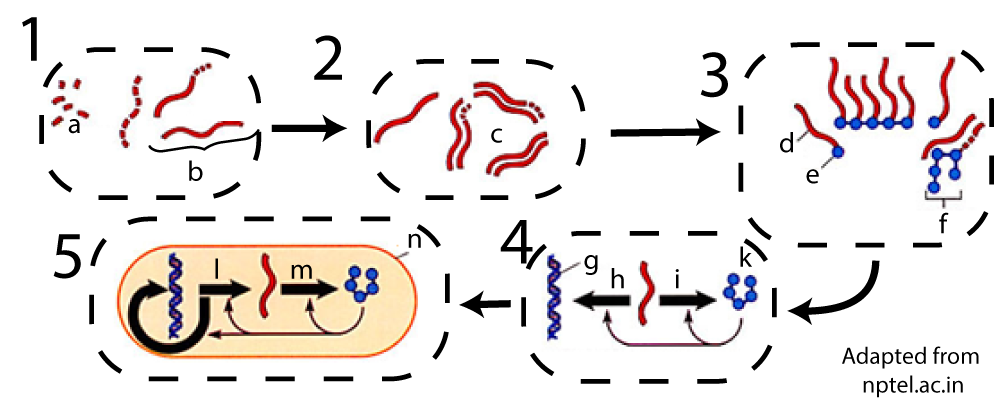 Step 1: Randomly sequenced RNA polymers (b) form from RNA monomers (a)
Step 1: Randomly sequenced RNA polymers (b) form from RNA monomers (a)- Step 2: RNA polymers serve as a template (c) for their own replication
- Step 3: RNA starts to associate with amino acids (e). Some of those amino acids polymerize into polypeptides (f).
- Step 4: RNA begins to translate itself (i) into proteins (K), which assist RNA in translation. Other proteins reverse transcribe (h) RNA into DNA (g), which starts to take on the role of storing genetic information.
- Step 5: The entire system becomes encapsulated within cells. DNA becomes the central genetic molecule. The universally used system of transcription of DNA into RNA (letter “l”) and translation of RNA into protein (m) emerges).
We’ll learn about encapsulation in the following section. Before that, take the following quiz about the RNA world.
3. The RNA World: Checking Understanding
[qwiz random = “true” qrecord_id=”sciencemusicvideosMeister1961-The RNA World (v2.0)”]
[h]The RNA World
[i]An origin of life haiku
An RNA world
Could these self-replicating
molecules evolve?
[q] DNA can only serve as an organism’s [hangman]. RNA, by contrast, can play DNA’s role, and also serve as [hangman]. Additional hint: think of two rhyming terms associated with genetics.
[c]IGdlbm90eXBl[Qq]
[f]IEdyZWF0IQ==[Qq]
[c]IHBoZW5vdHlwZQ==[Qq]
[f]IEdyZWF0IQ==[Qq]
[q] A conundrum associated with figuring out the origins of heredity is that DNA requires [hangman] to be replicated, but these proteins only exist because they’re coded for by [hangman].
[c]IHByb3RlaW5z[Qq]
[f]IEV4Y2VsbGVudCE=[Qq]
[c]IEROQQ==[Qq]
[f]IEdyZWF0IQ==[Qq]
[q] A general name for any RNA molecule with catalytic properties is a [hangman].
[c]IHJpYm96eW1l[Qq]
[f]IEdyZWF0IQ==[Qq]
[q] A ribozyme that you’ve come to know well in your studies of biology (perhaps without knowing that it was a ribozyme) is shown a “2” below. It’s a [hangman].
[c]IHJpYm9zb21l[Qq]
[f]IEV4Y2VsbGVudCE=[Qq]
[q] Infectious, single-stranded particles of RNA that parasitize plants are called [hangman]. Some biologists think that these are vestiges of the RNA [hangman]
[c]IHZpcm9pZHM=[Qq]
[f]IEdyZWF0IQ==[Qq]
[c]IHdvcmxk[Qq]
[f]IEV4Y2VsbGVudCE=[Qq]
[q] If the RNA world ever existed, it would have been before [hangman], the organism that’s at the base of the tree of life.
[c]IExVQ0E=[Qq]
[f]IENvcnJlY3Qh[Qq]
[q] For RNAs in the RNA world to be able to evolve, reproduction would have to be accompanied by [hangman], creating the variation that makes natural [hangman]possible.
[c]IG11dGF0aW9u[Qq]
[f]IENvcnJlY3Qh[Qq]
[c]IHNlbGVjdGlvbg==[Qq]
[f]IENvcnJlY3Qh[Qq]
[q] In the diagram below, which letter would represent abiotically formed RNA nucleotides?
[textentry single_char=”true”]
[c]IG E=[Qq]
[f]IEV4Y2VsbGVudC4gVGhlIGxldHRlciAmIzgyMjA7YSYjODIyMTsgcmVwcmVzZW50cyBhYmlvdGljYWxseSBmb3JtZWQgUk5BIG51Y2xlb3RpZGVzLg==[Qq]
[c]IEVudGVyIHdvcmQ=[Qq]
[f]IE5vLg==[Qq]
[c]ICo=[Qq]
[f]IE5vLiBMb29rIGZvciBhIG1vbm9tZXIgdGhhdCBjb3VsZCBzZXJ2ZSB0byBidWlsZCB1cCB0aGUgUk5BIChhIHBvbHltZXIpIHRoYXQgaXMgdGhlIHN0YXIgcGxheWVyIGluIHRoaXMgZGlhZ3JhbS4=[Qq]
[q] In the diagram below, which letter would represent the formation of randomly sequenced RNA molecules that have emerged through the formation of sugar-phosphate bonds between free RNA nucleotides?
[textentry single_char=”true”]
[c]IG I=[Qq]
[f]IEV4Y2VsbGVudC4gTGV0dGVyICYjODIyMDtiJiM4MjIxOyByZXByZXNlbnRzIGFiaW90aWNhbGx5IGZvcm1lZCBSTkEuIFRoZXJlIHdhcyBubyB0ZW1wbGF0ZSBkZXRlcm1pbmluZyB0aGUgc2VxdWVuY2Ugb2YgdGhlIFJOQSBudWNsZW90aWRlcywgc28gdGhhdCBzZXF1ZW5jZSBjYW4gYmUgdGhvdWdodCBvZiBhcyByYW5kb20u[Qq]
[c]IEVudGVyIHdvcmQ=[Qq]
[f]IFNvcnJ5LCB0aGF0JiM4MjE3O3Mgbm90IGNvcnJlY3Qu[Qq]
[c]ICo=[Qq]
[f]IE5vLiBMb29rIGZvciBSTkEgbW9sZWN1bGVzIHRoYXQgc2VlbSB0byBoYXZlIGZvcm1lZCB3aXRob3V0IGEgdGVtcGxhdGUu[Qq]
[q] In the diagram below, which letter represents template-driven RNA synthesis?
[textentry single_char=”true”]
[c]IG M=[Qq]
[f]IE5pY2UuIExldHRlciAmIzgyMjA7YyYjODIyMTsgcmVwcmVzZW50cyBSTkEgbW9sZWN1bGVzIHRoYXQgYXJlIGJlaW5nIHJlcGxpY2F0ZWQgYmFzZWQgb24gYSBwcmVleGlzdGluZyB0ZW1wbGF0ZS4=[Qq]
[c]ID I=[Qq]
[f]IE5pY2UuIExldHRlciAmIzgyMjA7YyYjODIyMTsgaW4gbnVtYmVyIDIgcmVwcmVzZW50cyBSTkEgbW9sZWN1bGVzIHRoYXQgYXJlIGJlaW5nIHJlcGxpY2F0ZWQgYmFzZWQgb24gYSBwcmVleGlzdGluZyB0ZW1wbGF0ZS4=[Qq]
[c]ICo=[Qq]
[f]IE5vLiBMb29rIGZvciBSTkEgbW9sZWN1bGVzIHRoYXQgc2VlbSB0byBiZSBmb3JtaW5nIGZyb20gb3RoZXIgUk5BIG1vbGVjdWxlcy4gUmVtZW1iZXIgdG8gY2hvb3NlIGEgbGV0dGVyLCBub3QgYSBudW1iZXIu[Qq]
[q] If the letter “e” represents an amino acid, then which letter below represents the first protein that would have emerged?
[textentry single_char=”true”]
[c]IG Y=[Qq]
[f]IE5pY2UuIFRoZSBsZXR0ZXIgJiM4MjIwO2YmIzgyMjE7IHJlcHJlc2VudHMgYW1pbm8gYWNpZHMgdGhhdCBoYXZlLCB0aHJvdWdoIHRoZSBhY3Rpb24gb2YgUk5BLCBiZWVuIHBvbHltZXJpemVkIGludG8gYSBwcm90ZWluLg==[Qq]
[c]IEVudGVyIHdvcmQ=[Qq]
[f]IFNvcnJ5LCB0aGF0JiM4MjE3O3Mgbm90IGNvcnJlY3Qu[Qq]
[c]ICo=[Qq]
[f]IE5vLiBMb29rIGZvciBhIG1vbGVjdWxlIHRoYXQgd291bGQgYmUgYSBwb2x5bWVyIG9mIGFuIGFtaW5vIGFjaWQgKHNob3duIGF0ICYjODIyMDtlJiM4MjIxOyku[Qq]
[q] At some point in the early evolution of life, RNA would have started coding for protein, a process known as translation. In the scenario proposed below, translation would have emerged before DNA, RNA, and protein became encapsulated into cells. Which letter shows translation first emerging?
[textentry single_char=”true”]
[c]IG k=[Qq]
[f]IE5pY2UuIFRoZSBsZXR0ZXIgJiM4MjIwO2kmIzgyMjE7IHJlcHJlc2VudHMgdHJhbnNsYXRpb24gaW4gYSBjZWxsLWZyZWUgc3lzdGVtLg==[Qq]
[c]IG0=[Qq]
[f]IE5vdCBxdWl0ZS4gVGhlIGxldHRlciAmIzgyMjA7bSYjODIyMTsgcmVwcmVzZW50cyB0cmFuc2xhdGlvbiwgYnV0IGl0JiM4MjE3O3MgaW5zaWRlIGEgY2VsbC4=[Qq]
[c]ICo=[Qq]
[f]IE5vLiBMb29rIGZvciBhbiBhcnJvdyB0aGF0IHJlcHJlc2VudHMgUk5BIHRoYXQmIzgyMTc7cyBiZWluZyB0cmFuc2xhdGVkIGludG8gcHJvdGVpbiwgYnV0IG91dHNpZGUgb2YgYSBjZWxsLg==[Qq]
[q] At some point in the evolution of life, DNA would have taken over from RNA as the molecule of heredity. In some viruses, genetic RNA is converted into DNA through a process called reverse transcription. Which arrow represents that process?
[textentry single_char=”true”]
[c]IG g=[Qq]
[f]IE5pY2UuIFRoZSBsZXR0ZXIgJiM4MjIwO2gmIzgyMjE7IHJlcHJlc2VudHMgdGhlIHJldmVyc2UgdHJhbnNjcmlwdGlvbiBvZiBETkEgZnJvbSBSTkEu[Qq]
[c]IEVudGVyIHdvcmQ=[Qq]
[f]IFNvcnJ5LCB0aGF0JiM4MjE3O3Mgbm90IGNvcnJlY3Qu[Qq]
[c]ICo=[Qq]
[f]IE5vLiBMb29rIGZvciBhIEROQSB0aGF0JiM4MjE3O3MgYmVpbmcgY3JlYXRlZCBiYXNlZCBvbiBpbmZvcm1hdGlvbiBmbG93aW5nIHRvIEROQSBmcm9tIFJOQS4gVGhhdCYjODIxNztzIHJldmVyc2UgdHJhbnNjcmlwdGlvbi4=[Qq]
[q] Once DNA emerged as the molecule of heredity, the process of DNA being transcribed into RNA would become a key process in the life of every cell. Which letter represents transcription?
[textentry single_char=”true”]
[c]IG w=[Qq]
[f]IE5pY2UuIFRoZSBsZXR0ZXIgJiM4MjIwO2wmIzgyMjE7IHJlcHJlc2VudHMgdGhlIHRyYW5zY3JpcHRpb24gb2YgUk5BIGZyb20gRE5BLg==[Qq]
[c]IGg=[Qq]
[f]wqA=Tm8uIFRoZSBsZXR0ZXIgJiM4MjIwO2gmIzgyMjE7IHJlcHJlc2VudHMgcmV2ZXJzZSB0cmFuc2NyaXB0aW9uLCBub3QgdHJhbnNjcmlwdGlvbi4=[Qq]
[c]ICo=[Qq]
[f]IE5vLiBMb29rIGZvciBhbiBhcnJvdyB0aGF0IGluZGljYXRlcyB0aGF0IGluZm9ybWF0aW9uIGZyb20gRE5BIGlzIGZsb3dpbmcgdG8gUk5BLg==[Qq]
[q] In the RNA world representation below, which letter represents RNA nucleotides?
[textentry single_char=”true”]
[c]IG I=[Qq]
[f]IE5pY2UuIFRoZSBsZXR0ZXIgJiM4MjIwO2ImIzgyMjE7IHJlcHJlc2VudHMgUk5BIG51Y2xlb3RpZGVzLg==[Qq]
[c]ICo=[Qq]
[f]IE5vLiBMb29rIGZvciB0aGUgbW9ub21lcnMgdGhhdCwgb25jZSBjb21iaW5lZCB0b2dldGhlciwgZm9ybSB0aGUgUk5BIHNob3duIGF0ICYjODIyMDtjJiM4MjIxOyBhbmQgJiM4MjIwO2QuJiM4MjIxOw==[Qq]
[q] In the RNA world representation below, which letter represents template-driven RNA replication of new RNA molecules.
[textentry single_char=”true”]
[c]IG U=[Qq]
[f]IEF3ZXNvbWUuIFRoZSBsZXR0ZXIgJiM4MjIwO2UmIzgyMjE7IHJlcHJlc2VudHMgUk5BIHBvbHltZXJzIHNlcnZpbmcgYXMgYSB0ZW1wbGF0ZSBmb3IgdGhlIHJlcHJvZHVjdGlvbiBvZiBuZXcgcG9seW1lcnMu[Qq]
[c]ICo=[Qq]
[f]IE5vLiBMb29rIGZvciBhIGRpYWdyYW0gdGhhdCBzaG93cyBSTkEgYmVpbmcgY29waWVkIGZyb20gb3RoZXIgUk5BLg==[Qq]
[q] In the RNA world representation below, which letter represents a protocell with RNA for its genetic material, and RNA-based enzymes?
[textentry single_char=”true”]
[c]IG Y=[Qq]
[f]IFRlcnJpZmljLiBUaGUgbGV0dGVyICYjODIyMDtmJiM4MjIxOyByZXByZXNlbnRzIGFuIFJOQS1iYXNlZCBwcm90b2NlbGwu[Qq]
[c]ICo=[Qq]
[f]IE5vLiBMb29rIGZvciBhIGRpYWdyYW0gdGhhdCBzaG93cyBzb21ldGhpbmcgdGhhdCBsb29rcyBsaWtlIGEgY2VsbC4=[Qq]
[x]
[restart]
[/qwiz]
4. Encapsulation: Forming Membranes and the First Cells
In the preceding section, both of the diagrammatic representations of the RNA world end with RNA or DNA becoming encapsulated within a membrane, forming a type of protocell.
|
|
|
To encapsulate means “to enclose within.” Of all the steps leading up to the origin of the first cells, the step of encapsulating an emerging living system within a membrane seems to be one of the most straightforward.
The following video from Stated Clearly does a great job explaining how abiotically generated fatty acids could self-organize to form micelles and then liposomes: fluid-filled spheres surrounded by a lipid bilayer. These liposomes set the stage for protocells.
In the quiz that follows, I threw in some concepts relating to membrane structure, which you probably learned earlier in your biology course. If you want to review, here’s a link to my tutorial about phospholipids and membrane structure (which has everything you need to know for the quiz)
5. Encapsulation, Forming Membranes Quiz
[qwiz random = “true” qrecord_id=”sciencemusicvideosMeister1961-Encapsulation: The Origin of Membranes (v2.0)”] [h]
Encapsulation: The Origin of Membranes
[i]
[q] The diagram below shows three representations of fatty acids. The part that is attracted to water is at number
[textentry single_char=”true”]
[c]ID I=[Qq]
[f]IFllcy4gUmVnaW9uIDIgaXMgYSBjYXJib3h5bGljIGFjaWQgZnVuY3Rpb25hbCBncm91cCwgYW5kIGl0IGhhcyBwb2xhciBhbmQgaHlkcm9waGlsaWMgcHJvcGVydGllcyB0aGF0IGNhdXNlIGl0IHRvIGJlIGF0dHJhY3RlZCB0byB3YXRlci4=[Qq]
[c]IEVudGVyIHdvcmQ=[Qq]
[f]IFNvcnJ5LCB0aGF0JiM4MjE3O3Mgbm90IGNvcnJlY3Qu[Qq]
[c]ICo=[Qq]
[f]IE5vLiBSZWdpb24gJiM4MjIwOzEmIzgyMjE7IGlzIGEgYmlnIGh5ZHJvY2FyYm9uIGNoYWluLiBUaGlzIHBhcnQgb2YgdGhlIG1vbGVjdWxlIHdvdWxkIGJlIGh5ZHJvcGhvYmljIChyZXBlbGxlZCBieSB3YXRlciku[Qq]
[q] The molecule shown below (in three different representations) is a(n) [hangman] acid.
[c]ZmF0dHk=[Qq]
[f]IEdyZWF0IQ==[Qq]
[q] To answer the question below, think about what you’ve already learned about cell membranes and lipid bilayers. In terms of interactions with water, part 2 of the molecule below can be described as[hangman].
[c]IGh5ZHJvcGhpbGlj[Qq]
[f]IEdyZWF0IQ==[Qq]
[q]To answer the question below, think about what you’ve already learned about cell membranes and lipid bilayers. In terms of interactions with water, part 1 of the molecule below can be described as [hangman].
[c]IGh5ZHJvcGhvYmlj[Qq]
[f]IEdyZWF0IQ==[Qq]
[q] According to the video, fatty acids can form [hangman] in environments that have mineral [hangman], and raw materials such as [hangman] monoxide and hydrogen.
[c]IGFiaW90aWNhbGx5[Qq]
[f]IEdyZWF0IQ==[Qq]
[c]IGNhdGFseXN0cw==[Qq]
[f]IEdyZWF0IQ==[Qq]
[c]IGNhcmJvbg==[Qq]
[f]IEdvb2Qh[Qq]
[q multiple_choice=”true”] The structure shown below is a
[c]IGNlbGw=[Qq]
[f]IE5vLiBUaGlzIHN0cnVjdHVyZSBzcG9udGFuZW91c2x5IGVtZXJnZXMgd2hlbiBtb2xlY3VsZXMgbGlrZSBmYXR0eSBhY2lkcyBpbnRlcmFjdCB3aXRoIG9uZSBhbm90aGVyIGluIGEgd2F0ZXJ5IGVudmlyb25tZW50Lg==[Qq]
[c]IGxpcGlkIGJpbGF5ZXI=[Qq]
[f]IE5vLiBUbyBiZSBhIGJpbGF5ZXIsIHlvdSBoYXZlIHRvIGhhdmUgVFdPIGxheWVycy4gSGVyZSB0aGVyZSYjODIxNztzIG9ubHkgb25lLg==[Qq]
[c]IA ==bWljZWxsZQ==[Qq]
[f]IE5pY2Ugam9iISBUaGUgc3RydWN0dXJlIHNob3duIGlzIGEgbWljZWxsZS4=[Qq]
[q] The structure shown below contains a lipid [hangman]
[c]IGJpbGF5ZXI=[Qq]
[f]IENvcnJlY3Qh[Qq]
[q] The structure shown below —an empty phospholipid bilayer — is called a [hangman]. In terms of life’s emergence, these structures would have formed the outer boundary of the first [hangman].
[c]IGxpcG9zb21l[Qq]
[c]cHJvdG9jZWxs[Qq]
[f]IENvcnJlY3Qh[Qq]
[q multiple_choice=”true”] Structures like the one shown below
[c]IHJlc3VsdCBmcm9tIGRlaHlkcmF0aW9uIHN5bnRoZXNpcyByZWFjdGlvbnMu[Qq]
[f]IE5vLiBUaGF0JiM4MjE3O3MgaG93IGVuenltZXMgY29uc3RydWN0IHBvbHltZXJzIGZyb20gbW9ub21lcnMuIFdoYXQmIzgyMTc7cyBoYXBwZW5pbmcgaGVyZSByZXN1bHRzIGZyb20gdGhlIHByb3BlcnRpZXMgb2YgdGhlIG1vbGVjdWxlcyBzaG93biwgdGhlaXIgaW50ZXJhY3Rpb25zIHdpdGggZWFjaCBvdGhlciwgYW5kIHRoZWlyIGludGVyYWN0aW9ucyB3aXRoIHdhdGVyLg==[Qq]
[c]IHJlc3VsdCBmcm9tIGVuenltZXMgdGhhdCBldm9sdmVkIHRvIHBsYWNlIGVhY2ggbW9sZWN1bGUgaW4gYSBzcGVjaWZpYyBwb3NpdGlvbi4=[Qq]
[f]IE5vLiBXaGF0JiM4MjE3O3MgaGFwcGVuaW5nIGhlcmUgcmVzdWx0cyBmcm9tIHRoZSBwcm9wZXJ0aWVzIG9mIHRoZSBtb2xlY3VsZXMgc2hvd24sIHRoZWlyIGludGVyYWN0aW9ucyB3aXRoIGVhY2ggb3RoZXIsIGFuZCB0aGVpciBpbnRlcmFjdGlvbnMgd2l0aCB3YXRlci4=[Qq]
[c]IHJlc3VsdCBhcyBhbiBlbWVyZ2VudCBwcm9wZXJ0eSBvZiB0aGUgbW9sZWN1bGVzIHRoZXkmIzgyMTc7cmUgbWFkZSBvZiwg dGhlIHdheSB0aGV5IGludGVyYWN0IHdpdGggZWFjaCBvdGhlciwgYW5kIGhvdyB0aGV5IGludGVyYWN0IHdpdGggd2F0ZXIu[Qq]
[f]IE5pY2Ugam9iISBUaGF0JiM4MjE3O3MgaG93IHN0cnVjdHVyZXMgbGlrZSB0aGUgb25lIHNob3duIGVtZXJnZS4=[Qq]
[q multiple_choice=”true”] The video describes a sequence in which the first membrane-like structures emerge. Which of the following best summarizes this process?
[c]IG1pY2VsbGVzIGRpc2FnZ3JlZ2F0ZSBpbnRvIGJpbGF5ZXJlZCBjZWxsLWxpa2Ugc3RydWN0dXJlcywgZWFjaCBvZiB3aGljaCBoYXMgYW4gb3V0ZXIgbWVtYnJhbmUgd2l0aCBhIGJpbGF5ZXJlZCBzdHJ1Y3R1cmU=[Qq]
[f]IE5vLiBXaGlsZSB0aGUgbWljZWxsZXMgY2FuIGZvcm0gaW50byBiaWxheWVyZWQgbWVtYnJhbmVzLCB0aGV5IGRvbiYjODIxNzt0IGRvIHNvIHRocm91Z2ggJiM4MjIwO2Rpc2FnZ3JlZ2F0aW9uLCYjODIyMTsgd2hpY2ggd291bGQgaGF2ZSB0aGUgb3Bwb3NpdGUgZWZmZWN0Lg==[Qq]
[c]IGZhdHR5IGFjaWRzIGZvcm0gbWljZWxsZXMsIHdoaWNoIGFnZ3JlZ2F0ZSB0byBmb3JtIGxpcGlkIHNraW5zLCB3aGljaCBmb2xk IGluIHVwb24gdGhlbXNlbHZlcyB0byBmb3JtIGZsdWlkLWZpbGxlZCBzcGhlcmVzIHdpdGggYmlsYXllcmVkIG1lbWJyYW5lcy4=[Qq]
[f]IEV4YWN0bHkuIFRoZSBrZXkgcG9pbnQgbyB0aGUgdmlkZW8gaXMgYSBzZXF1ZW5jZSB3aGVyZSBmYXR0eSBhY2lkcyBpbnRlcmFjdCB0byBmb3JtIG1pY2VsbGVzLCB3aGljaCBpbnRlcmFjdCB0byBmb3JtIGxpcGlkICYjODIyMDtza2lucywmIzgyMjE7IHdoaWNoIGNhbiBmb2xkIGluIHVwb24gdGhlbXNlbHZlcyB0byBmb3JtIGZsdWlkLWZpbGxlZCBzcGhlcmVzIHdpdGggYmlsYXllciBleHRlcmlvcnMu[Qq]
[c]IGJpbGF5ZXJlZCBwcm90b2NlbGxzIGZpcnN0IGZvcm0gYXMgb3RoZXIgcHJvdG9jZWxscyB3aXRoIGJpbGF5ZXJlZCBtZW1icmFuZXMgc3RyZXRjaCB1bnRpbCB0aGVpciBtZW1icmFuZXMgdG91Y2gsIGdpdmluZyByaXNlIHRvIG5ldyBwcm90b2NlbGxzLCBhbmQga2lja3N0YXJ0aW5nIGV2b2x1dGlvbi4=[Qq]
[f]IE5vLiBPbmNlIHN1Y2ggYSBzeXN0ZW0gaGFzIHN0YXJ0ZWQsIGl0IGNvdWxkIGtlZXAgZ29pbmcgdGhyb3VnaCBhIG1lY2hhbmlzbSBsaWtlIHRoZSBvbmUgZGVzY3JpYmVkIGFib3ZlLiBCdXQgaG93IGRpZCB0aGUgZmlyc3QgcHJvdG9jZWxscyBlbWVyZ2U/[Qq]
[c]IGZhdHR5IGFjaWRzIHNwb250YW5lb3VzbHkgZW1lcmdlIGFzIG1pY2VsbGVzIGZyb20gdGhlIHByaW1vcmRpYWwgc291cC4gVGhlc2UgbWljZWxsZXMgZXZvbHZlIGludG8gdGhlIGZpcnN0IGNlbGxzLCBraWNrc3RhcnRpbmcgZXZvbHV0aW9uLg==[Qq]
[f]IE5vLiBUaGF0IHNvdW5kcyBsaWtlIHRoZSBraW5kIG9mIG1pcmFjdWxvdXMgZXhwbGFuYXRpb24gdGhhdCB3ZSYjODIxNzt2ZSBiZWVuIHRyeWluZyB0byBhdm9pZC4=[Qq]
[q] The diagram below shows a molecule called a [hangman]. This molecule is composed of two [hangman] acids connected to glycerol and a phosphate. At some point in the course of evolution, the molecule below became the key component of [hangman] in all organisms in domains eukarya and bacteria.
[c]cGhvc3Bob2xpcGlk
[c]ZmF0dHk=[Qq]
[c]bWVtYnJhbmVz[Qq]
[x][restart]
[/qwiz]
6. What’s Next?
Proceed to Topic 7.12, Part 4: Where it all Happened. Alkaline Hydrothermal Vents are a Promising Location for Life’s Origins, the next (and the last) tutorial in Topic 7.12, the Origin of Life.

